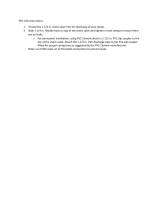
2
I-UEZ (02-21) 1034347-0
TABLE OF CONTENTS
GENERAL INFORMATION ................................................................... 4
References .............................................................................. 4
Important Safety Information................................................................. 4
Certification .............................................................................. 5
Warranty ................................................................................ 5
Installation Codes ......................................................................... 5
Unit Location ............................................................................. 5
Heater Throw............................................................................. 6
Mounting Height Requirements............................................................... 7
Hazards of Chlorine........................................................................ 7
Dimensions . . . . . . . . . . . . . . . . . . . . . . . . . . . . . . . . . . . . . . . . . . . . . . . . . . . . . . . . . . . . . . . . . . . . . . . . . . . . . . 7
Clearances .............................................................................. 8
Weights ................................................................................. 9
Venting and Combustion Air Requirements ..................................................... 9
Vent/Combustion Air System Piping Requirements ............................................. 9
Vent/Combustion Air System Piping Joints ..................................................11
Vent/Combustion Air System Piping Support.................................................12
Technical Data ..........................................................................13
INSTALLATION.......................................................................... 14
Unpacking and Inspection..................................................................14
Pre-Installation Checklist................................................................... 14
Heater Suspension .......................................................................15
Suspension of Heater with Downturn Nozzle .................................................15
Piping Connections .......................................................................16
Gas Supply Pressure ...................................................................16
Gas Supply Piping .....................................................................16
Supply Piping Connections ..............................................................17
Concentric Adapter Box Connections .........................................................18
Vent Terminal Options.....................................................................20
Vertical Vent Terminal (Option CC2) Installation ..............................................20
Horizontal Vent Terminal (Option CC6) Installation ............................................24
Condensate Drain Installation ............................................................... 28
Vent Condensate Drain Installation ........................................................29
Heat Exchanger Condensate Drain Installation ...............................................32
Electrical Connections..................................................................... 32
CONTROLS .............................................................................. 33
Thermostat Options....................................................................... 34
Main Operating Gas Valve .................................................................35
Pressure Switch .........................................................................35
High Temperature Limit Control .............................................................35
Vent Temperature Limit Switch .............................................................. 36
Interlock Door Switch .....................................................................36
Fan Motor ..............................................................................36
Circuit Board (DSI Control Module)........................................................... 36
Venter Motor . . . . . . . . . . . . . . . . . . . . . . . . . . . . . . . . . . . . . . . . . . . . . . . . . . . . . . . . . . . . . . . . . . . . . . . . . . . . 36




















